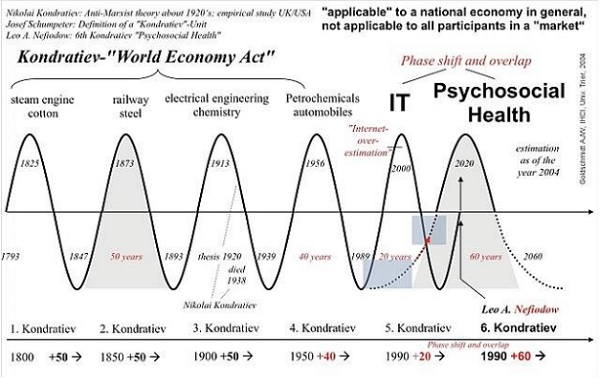
 Data Structure
Data Structure Networking
Networking RDBMS
RDBMS Operating System
Operating System Java
Java MS Excel
MS Excel iOS
iOS HTML
HTML CSS
CSS Android
Android Python
Python C Programming
C Programming C++
C++ C#
C# MongoDB
MongoDB MySQL
MySQL Javascript
Javascript PHP
PHP
- Selected Reading
- UPSC IAS Exams Notes
- Developer's Best Practices
- Questions and Answers
- Effective Resume Writing
- HR Interview Questions
- Computer Glossary
- Who is Who
What Is a Kondratieff Wave and How Does It Work?
The Kondratieff Wave, named after Russian economist Nikolai Kondratieff, is a term that refers to cycles that occur in capitalist economies and span between 40 and 60 years in length. "Kondratiev waves," "super-cycles," "K-waves," "surges," and/or "long waves" are all terms used to describe these types of waves.

Kondratieff Waves Cycles. Image Source
Important Takeaways
The Kondratieff Wave, also known as super-cycles, K-waves, surges, and long waves, is a series of cycles that occur in capitalist economies and span about 40 to 60 years in duration.
One kind of long-term economic cycle is the Kondratieff Wave, which is characterized by phases of development and self-correction that are brought about by technical progress and culminate in a lengthy period of prosperity.
Known as "heterodox economics," Kondratieff Waves are a theory that has been rejected in Kondratieff's native country and has been consigned to a subfield of economics known as "heterodox economics," which means it does not correspond to the generally recognized, orthodox ideas advocated by economists.
What is the mechanism through which Kondratieff waves operate?
Kondratieff discovered a number of long-term cycles that alternate between periods of rapid growth and periods of sluggish development in the economy. Agriculture commodities and copper prices in European nations were the primary drivers of the cycles, and he noticed periods of development in the many economic activities that were carried out in the home economies throughout his research.
The cycles lasted about 50 to 60 years and were made up of a number of phases that were repeated in nature on a regular basis. The cycles that have been recognized are as follows −
-
The very first cycle − Development of Steam engine
The first cycle, which lasted from 1780 to 1830, was driven by the development of the steam engine as well as the expansion of the textile industry during that time period.
-
The Second Iteration − Birth of Steel industry
The second cycle, which spanned the years 1830 to 1880, was sparked by the birth of the steel industry, which occurred at the same time as the development of the Bessemer converter. In addition to supporting mass movement of both people and goods, the expansion of rail transportation facilitated fast economic development.
-
The Third Cycle from 1880 − 1930
From 1880 to 1930, the world was in the third cycle. Because it was the first wave to be generated by the actual application of scientific knowledge, it is noteworthy for this distinction. It happened at the period of rapid growth of electrical power. It was also the era in which technological advances in the chemical industry made it possible to mass produce goods in large quantities.
-
Cycle number four − 1930 − 1970
The fourth cycle, which lasted from 1930 to 1970 and was driven by the expansion of the petrochemical sector, happened during this period. The expansion of the petrochemical sector contributed to the expansion of the automobile industry. When the Organization of Petroleum Exporting Countries (OPEC) raised the price of crude oil in the 1970s, the cycle came to an end, causing a recession in the United States.
-
Fifth Cycle − Computer Technology
After the fourth cycle ended in the 1970s, the fifth cycle was sparked by the introduction of computer-based information technology. The shift from an industrial society to an information society started, and the globe became a global village as a result of this transformation.
-
The Sixth Cycle − Healthcare
Many economists think that we are now in the midst of the sixth Kondratieff wave, which began about 2005. They mainly think that advancements in healthcare will serve as a catalyst for this cycle. Improved productivity in the management of healthcare problems will be the driving force behind economic development.

